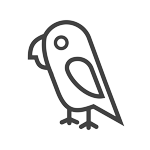
Maltese Shih Tzu: Temperament, Size, Care & Facts for Aussie Pet Lovers
If you're on the hunt for the perfect pint-sized companion with a heart full of love, the Maltese Shih Tzu might just steal yours. Known for their affectionate nature, low-shedding coats, and lively personalities, these adorable hybrids have become one of Australia's favourite small dog breeds. Whether you're living the city life in Sydney or enjoying the wide-open spaces of regional Queensland, the Maltese Shih Tzu adapts beautifully to many lifestyles.
Also fondly called a Malshi or Malti Tzu, this delightful designer breed blends the best traits of the Maltese and Shih Tzu. But before you rush to add one to your family, there's plenty to learn to ensure they're the right fit for you. Let's dive into everything you need to know!
What is a Maltese Shih Tzu?
The Maltese Shih Tzu is a crossbreed between a purebred Maltese and a purebred Shih Tzu, developed to create a small, friendly, low-shedding companion dog. First bred in the 1990s, this "designer dog" was aimed at combining the best characteristics of both parent breeds while reducing common health issues.
Known by other names like Malshi and Malti Tzu, these dogs boast a winning combination of charm, intelligence, and manageable grooming needs. Unlike many hybrid breeds, the Maltese Shih Tzu is consistently bred for temperament and appearance, making them reliably loving companions.
Maltese Shih Tzu Size and Appearance

How Big Does a Maltese Shih Tzu Get?
Perfectly portable, Maltese Shih Tzus are generally considered a "toy" breed. When full grown, they typically weigh between 4 to 7 kilograms and stand about 20 to 30 centimetres tall at the shoulder.
Their appearance can vary slightly depending on which parent breed they take after more. Common traits include:
-
A round face with large, expressive eyes
-
A soft, flowing coat that may be straight or slightly wavy
-
A sturdy, well-balanced body despite their small size
Popular Coat Colours
Maltese Shih Tzus come in a variety of beautiful shades, including:
-
White
-
Black
-
Brown
-
Tri-colour mixes
Cream or white coats with patches of tan or gold are particularly popular among Aussie owners, as they often highlight the breed's teddy bear-like cuteness.
Maltese Shih Tzu Temperament: Are They Good Pets?
One of the biggest reasons Aussies fall in love with Maltese Shih Tzus is their incredible temperament.
These dogs are:
-
Affectionate: They form strong bonds with their families and love being involved in daily activities.
-
Sociable: Generally friendly with children, seniors, and other pets when properly socialised.
-
Alert: They're quick to let you know if something's amiss, but they're rarely aggressive.
-
Adaptable: Whether you live in a high-rise apartment in Melbourne or a rural property in WA, they'll fit right in.
Are Maltese Shih Tzus Good Pets for Families?
Absolutely. Their playful yet gentle nature makes them ideal for households with kids, and their manageable size is perfect for elderly owners seeking companionship. Early training and positive reinforcement are key to nurturing their best behaviours.
Maltese Shih Tzu Grooming Needs

Do Maltese Shih Tzus Shed a Lot?
The Maltese Shih Tzu is often marketed as "low-shedding" or "hypoallergenic," though no dog is truly hypoallergenic. Thanks to their Maltese lineage, they shed far less than many breeds, making them a great choice for allergy sufferers.
Grooming Essentials
-
Daily brushing: To prevent tangles and mats.
-
Professional grooming: Every 6-8 weeks to keep their coat manageable.
-
Bathing: Every 3-4 weeks with gentle dog shampoo.
-
Ear cleaning and teeth brushing: Regular maintenance to avoid infections.
Their beautiful coat needs commitment, but the payoff is a soft, silky companion that looks gorgeous year-round.
Health and Common Issues in Maltese Shih Tzus
Common Health Issues
While crossbreeding can sometimes reduce the risk of genetic diseases, Maltese Shih Tzus are still prone to a few health conditions:
-
Brachycephalic syndrome: Due to their short snouts, breathing problems may arise, especially in hot Australian summers.
-
Dental issues: Small breeds are prone to tartar buildup and gum disease.
-
Eye problems: Dry eye and cataracts are not uncommon.
-
Allergies: Environmental and food allergies may occur.
Is a Maltese Shih Tzu Hypoallergenic?
They are considered a good choice for allergy sufferers due to their minimal shedding, but individual sensitivities vary. Always spend time with a Maltese Shih Tzu before committing if allergies are a concern.
Training a Maltese Shih Tzu Puppy

Tips for Successful Training
-
Start early: Begin basic obedience and house training from 8 weeks old.
-
Use positive reinforcement: Treats, praise, and play work wonders.
-
Stay patient: They are clever but can inherit a stubborn streak from the Shih Tzu side.
-
Socialisation: Introduce to different people, places, and pets from an early age.
With consistent training, the Maltese Shih Tzu becomes a polite, well-mannered companion.
Feeding and Nutrition: What Should a Maltese Shih Tzu Eat?
Diet Essentials
-
High-quality kibble or fresh food: Formulated for small breeds.
-
Portion control: Obesity can be a problem if overfed.
-
Special attention: If prone to allergies, opt for grain-free or hypoallergenic diets.
Puppies require more frequent feeding (three to four times daily), while adults thrive on two meals a day.
Exercise Needs: Keeping Your Maltese Shih Tzu Happy
Despite their small stature, Maltese Shih Tzus are lively and enjoy daily walks and play sessions.
-
Walks: Two short walks (15-20 minutes each) daily
-
Indoor play: Great for apartment living
-
Mental stimulation: Puzzle toys and basic trick training help keep their minds sharp
Their energy levels are moderate, so they don't need the intense exercise that larger breeds require.
Costs of Owning a Maltese Shih Tzu in Australia

Maltese Shih Tzu Cost Overview
-
Puppy price: AUD $1,500 to $4,000 depending on breeder quality
-
Initial setup: Bed, lead, crate, toys, vaccinations - approximately $800–$1,000
-
Ongoing costs: Food, grooming, vet care, pet insurance, around $1,200–$2,000 annually
Buying from a responsible breeder or adopting from a reputable rescue ensures your pet is healthy and ethically sourced.
If you are searching for a small, loyal, affectionate dog that thrives in a loving home, the Maltese Shih Tzu ticks all the boxes. With their charming personalities, manageable exercise needs, and undeniable cuteness, it's no wonder they are adored by so many Australian families.
However, they do require a commitment to grooming and proper health care. If you're prepared to give them the attention and love they crave, you'll have a devoted mate for life.
At Pet PaWz, we've got everything you need to pamper your new best mate — from cosy dog beds perfect for tiny legs, puppy pads for early house training, to convenient pet ramps that make climbing up the couch a breeze. Shop our top-rated Aussie pet essentials today and make every day a tail-wagging adventure!
FAQs
How Big Does a Maltese Shih Tzu Get?
On average, 4 to 7 kilograms and about 20 to 30 centimetres tall.
Are Maltese Shih Tzus Good Pets?
Absolutely. They're affectionate, friendly, and adaptable for many lifestyles, from families with kids to seniors seeking companionship.
Is a Maltese Shih Tzu Hypoallergenic?
While no dog is completely hypoallergenic, Maltese Shih Tzus are low-shedding and generally better for allergy sufferers.
Do Maltese Shih Tzus Bark a Lot?
They are alert and may bark to alert you to visitors, but excessive barking can be managed with proper training and early socialisation.
Can a Maltese Shih Tzu Be Left Alone?
Maltese Shih Tzus can tolerate short periods alone, but they thrive on companionship and may develop separation anxiety if left for extended periods. Training them gradually to be comfortable alone and providing interactive toys can help.
What is the Common Problem with Shih Tzus?
Common problems in Shih Tzus include breathing difficulties due to their brachycephalic (short-nosed) structure, eye issues like dry eye or corneal ulcers, and dental disease due to their small mouths. Regular vet checks, grooming, and a healthy diet help manage these risks.










Leave a comment